An Engine Exhaust Utilization System by Combining CO2 Brayton Cycle and Transcritical Organic Rankine Cycle
Abstract
:1. Introduction
2. Cycle Structure
3. Mathematical Model
3.1. Thermodynamic Analysis
3.2. Heat Transfer Area
3.3. Economic Analysis
4. Results and Discussion
4.1. Effect of CO2 Turbine Inlet Pressure pCO2T,in
4.2. Effect of CO2 Turbine Inlet Temperature TCO2T,in
4.3. Effect of Compressor Inlet Pressure pC,in
4.4. Effect of Compressor Inlet Temperature TC,in
4.5. Effect of ORC Turbine Inlet Pressure pORCT,in
4.6. Effect of ORC Turbine Inlet Temperature TORCT,in
4.7. Multi-Objective Optimization
4.8. Exergy Distribution at Optimized Condition
4.9. Discussion
5. Conclusions
- (1)
- A new power system is proposed by integrating supercritical CO2 Brayton cycle and transcritical ORC, which is eco-friendly, compact, stable, and highly efficient.
- (2)
- The increase in the CO2 turbine inlet pressure and temperature is positive for system performance. There is an optimized compressor inlet pressure associated with exergy efficiency. The compressor inlet temperature should be as low as possible.
- (3)
- There is a maximum value of system exergy efficiency and minimum value of levelized cost of energy by varying the ORC turbine inlet pressure. The increase in ORC turbine inlet temperature improves the system exergy efficiency and reduces the levelized cost of energy.
- (4)
- The determined exergy efficiency and levelized cost of energy in the proposed system are 54.63% and 36.95 USD/MWh after multi-objective optimization.
Author Contributions
Funding
Institutional Review Board Statement
Informed Consent Statement
Data Availability Statement
Conflicts of Interest
References
- Berardi, U. Building energy consumption in US, EU, and BRIC countries. Proc. Eng. 2015, 118, 128–136. [Google Scholar] [CrossRef] [Green Version]
- Steinmann, W.D. Thermo-mechanical concepts for bulk energy storage. Renew. Sustain. Energy Rev. 2017, 75, 205–219. [Google Scholar] [CrossRef]
- Morgan, R.; Dong, G.Y.; Panesar, A.; Heikal, M. A comparative study between a Rankine cycle and a novel intra-cycle based waste heat recovery concepts applied to an internal combustion engine. Appl. Energy 2016, 174, 108–117. [Google Scholar] [CrossRef] [Green Version]
- Rahbar, K.; Mahmoud, S.; Al-Dadah, R.K.; Moazami, N.; Mirhadizadeh, S.A. Review of organic Rankine cycle for small-scale applications. Energy Convers. Manag. 2017, 134, 135–155. [Google Scholar] [CrossRef]
- Sun, W.; Yue, X.; Wang, Y. Exergy efficiency analysis of ORC (Organic Rankine Cycle) and ORC-based combined cycles driven by low-temperature waste heat. Energy Convers. Manag. 2017, 135, 63–73. [Google Scholar] [CrossRef]
- Tian, H.; Shu, G.; Wei, H.; Liang, X.; Liu, L. Fluids and parameters optimization for the organic Rankine cycles (ORCs) used in exhaust heat recovery of Internal Combustion Engine (ICE). Energy 2012, 47, 125–136. [Google Scholar] [CrossRef]
- Su, X.; Shedd, T.A. Towards working fluid properties and selection of Rankine cycle based waste heat recovery (WHR) systems for internal combustion engines-a fundamental analysis. Appl. Therm. Eng. 2018, 142, 502–510. [Google Scholar] [CrossRef]
- Vaja, I.; Gambarotta, A. Internal Combustion Engine (ICE) bottoming with Organic. Rankine. Cycles (ORCs). Energy 2010, 35, 1084–1093. [Google Scholar] [CrossRef]
- Kim, M.; Shin, G.; Kim, G.; Cho, B. Single-loop organic Rankine cycle for engine waste heat recovery using both low-and high-temperature heat sources. Energy 2016, 96, 482–494. [Google Scholar] [CrossRef]
- Wang, X.; Shu, G.; Tian, H.; Liu, P.; Jing, D.; Li, X. Dynamic analysis of the dual-loop Organic Rankine Cycle for waste heat recovery of a natural gas engine. Energy Convers. Manag. 2017, 148, 724–736. [Google Scholar] [CrossRef]
- Ping, X.; Yao, B.F.; Zhang, H.G.; Yang, F.B. Thermodynamic, economic, and environmental analysis and multi-objective optimization of a dual loop organic Rankine cycle for CNG engine waste heat recovery. Appl. Therm. Eng. 2021, 193, 1169–1180. [Google Scholar] [CrossRef]
- Civgin, M.G.; Deniz, C. Analyzing the dual-loop organic Rankine cycle for waste heat recovery of container vessel. Appl. Therm. Eng. 2021, 199, 1175–1182. [Google Scholar] [CrossRef]
- Schuster, A.; Karellas, S.; Aumann, R. Efficiency optimization potential in supercritical Organic Rankine Cycles. Energy 2010, 35, 1033–1049. [Google Scholar] [CrossRef]
- Yang, M.H. Thermal and economic analyses of a compact waste heat recovering system for the marine diesel engine using trascritical Rankine cycle. Energy Convers. Manag. 2015, 106, 1082–1096. [Google Scholar] [CrossRef]
- Yağlı, H.; Koç, Y.; Koç, A.; Görgülü, A.; Tandiroğlu, A. Parametric optimization and exergetic analysis comparison of subcritical and supercritical organic Rankine cycle (ORC) for biogas fuelled combined heat and power (CHP) engine exhaust gas waste heat. Energy 2016, 111, 923–932. [Google Scholar] [CrossRef]
- Wang, E.; Yu, Z.; Zhang, H.; Yang, F. A regenerative supercritical dual-loop organic Rankine cycle system for energy recovery from the waste heat of internal combustion engines. Appl. Energy 2017, 190, 574–590. [Google Scholar] [CrossRef]
- Shi, L.; Shu, G.; Tian, H.; Deng, S. A review of modified Organic Rankine cycles (ORCs) for internal combustion engine waste heat recovery (ICE-WHR). Renew. Sustain. Energy Rev. 2018, 92, 95–110. [Google Scholar] [CrossRef]
- Rajabloo, T.; Bonalumi, D.; Lora, P. Effect of a partial thermal decomposition of the working fluid on the performances of ORC power plants. Energy 2017, 133, 1013–1026. [Google Scholar] [CrossRef]
- EI-Harbawi, M.; Shaaran, S.; Ahmad, F.; Wahi, M.; Abdul, A.; Larid, D.; Yi, C.-H. Estimating the flammability of vapours above refinery wastewater laden with hydrocarbon mixtures. Fire Saf. J. 2012, 51, 61–67. [Google Scholar] [CrossRef] [Green Version]
- Astolfi, M.; Alfani, D.; Lasala, S.; Macchi, E. Comparison between ORC and CO2 power systems for the exploitation of low-medium temperature heat sources. Energy 2018, 161, 1250–1261. [Google Scholar] [CrossRef]
- Meng, F.X.; Wang, E.H.; Zhang, B.; Zhang, F.J.; Zhao, C.L. Thermo-economic analysis of transcritical CO2 power cycle and comparison with Kalina cycle and ORC for a low temperature heat source. Energy Convers. Manag. 2019, 195, 1295–1308. [Google Scholar] [CrossRef]
- Yu, G.; Shu, G.; Tian, H.; Huo, Y.; Zhu, W. Experimental investigations on a cascaded steam-/organic-Rankine-cycle (RC/ORC) system for waste heat recovery (WHR) from diesel engine. Energy Convers. Manag. 2016, 129, 43–51. [Google Scholar] [CrossRef]
- Zhang, C.; Shu, G.; Tian, H.; Wei, H.; Liang, X. Comparative study of alternative ORC based combined power systems to exploit high temperature waste heat. Energy Convers. Manag. 2015, 89, 541–554. [Google Scholar] [CrossRef]
- Liu, Z.; Liu, X.; Zhang, W.F.; Yang, S.J.; Li, H.L.; Yang, X.H. Thermodynamic analysis on the feasibility of a liquid energy storage system using CO2-based mixture as the working fluid. Energy 2022, 238, 1217–1229. [Google Scholar] [CrossRef]
- Shu, G.Q.; Yu, Z.G.; Tian, H.; Liu, P.; Xu, Z.Q. Potential of the transcritical Rankine cycle using CO2-based binary zeotropic mixtures for engine’s waste heat recovery. Energy Convers. Manag. 2018, 174, 668–685. [Google Scholar] [CrossRef]
- Liu, Z.; Liu, Z.H.; Xin, X.; Yang, X.H. Proposal and assessment of a novel carbon dioxide energy storage system with electrical thermal storage and ejector condensing cycle: Energy and exergy analysis. Appl. Energy 2020, 269, 1150–1167. [Google Scholar] [CrossRef]
- Liu, Z.; Liu, Z.H.; Yang, X.Q.; Zhai, H.Y.; Yang, X.H. Advanced exergy and exergoeconomic analysis of a novel liquid carbon dioxide energy storage system. Energy Convers. Manag. 2020, 205, 1123–1131. [Google Scholar] [CrossRef]
- Liu, Z.; Liu, Z.H.; Cao, X.; Li, H.L.; Yang, X.H. Self-condensing transcritical CO2 cogeneration system with extraction turbine and ejector refrigeration cycle: A techno-economic assessment study. Energy 2020, 208, 1183–1191. [Google Scholar] [CrossRef]
- Cayer, E.; Galanis, N.; Desilets, M.; Nesreddine, H.; Roy, P. Analysis of a carbon dioxide transcritical power cycle using a low teperature source. Appl. Energy 2009, 86, 1055–1063. [Google Scholar] [CrossRef]
- Ipakchi, O.; Mosaffa, A.H.; Farshi, L.G. Ejector based CO2 transcritical combined cooling and power system utilizing waste heat recovery: A thermoeconomic assessment. Energy Convers. Manag. 2019, 186, 462–472. [Google Scholar] [CrossRef]
- Morandin, M.; Mercangöz, M.; Hemrle, J.; Maréchal, F.; Favrat, D. Thermoeconomic design optimization of a thermo-electric energy storage system based on transcritical CO2 cycles. Energy 2013, 58, 571–587. [Google Scholar] [CrossRef]
- Lemmon, E.W.; Huber, M.L.; McLinden, M.O. NIST Standard Reference Database 23: Reference Fluid Thermodynamic and Transport Properties-REFPROP, Version 9.1; National Institute of Standards and Technology, Standard Reference Data Program: Gaithersburg, ML, USA, 2013.
- Huang, W.G.; Wang, J.F.; Xia, J.X.; Zhao, P.; Dai, Y.P. Performance analysis and optimization of a combined cooling and power system using low boiling point working fluid driven by engine waste heat. Energy Convers. Manag. 2019, 180, 962–976. [Google Scholar] [CrossRef]

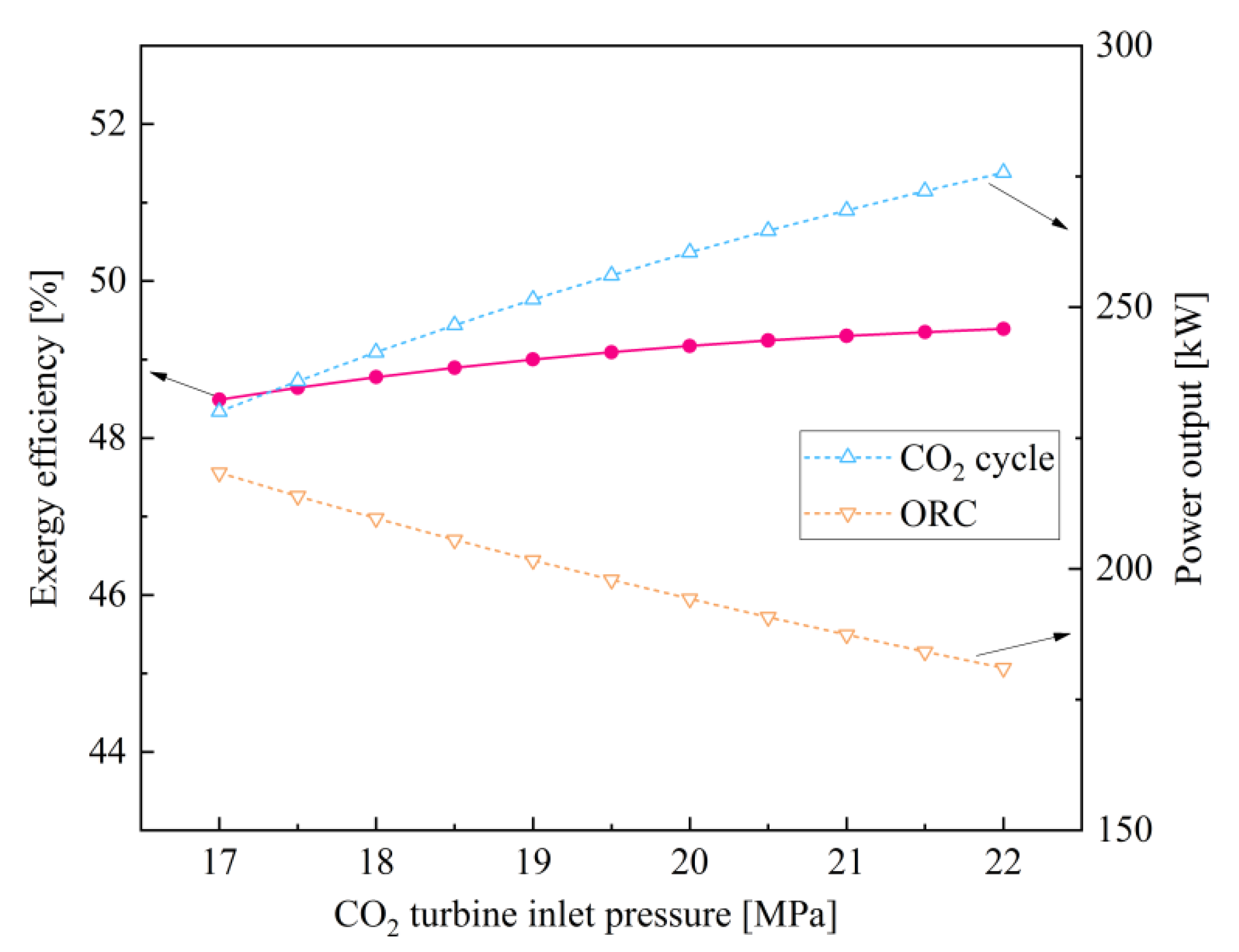
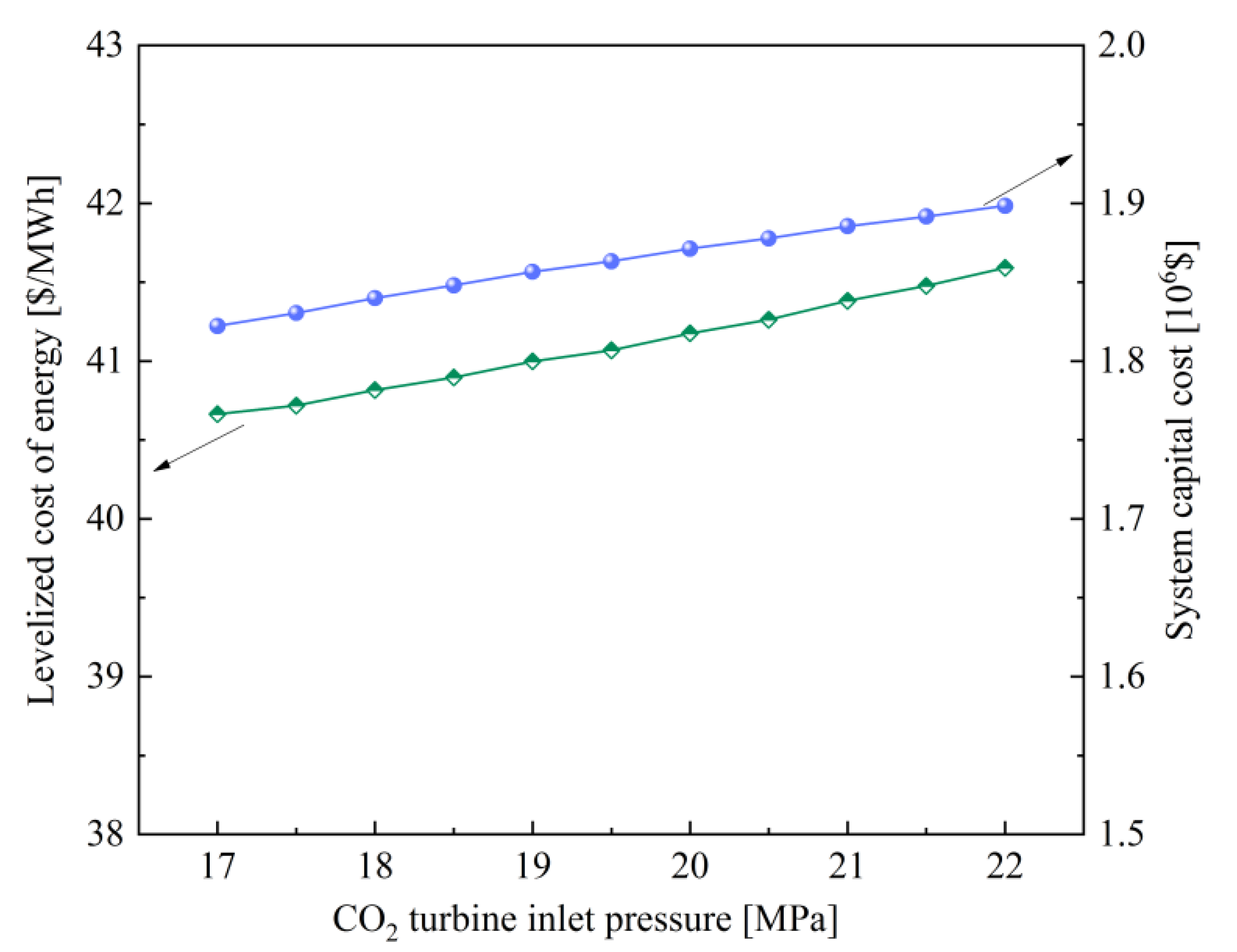
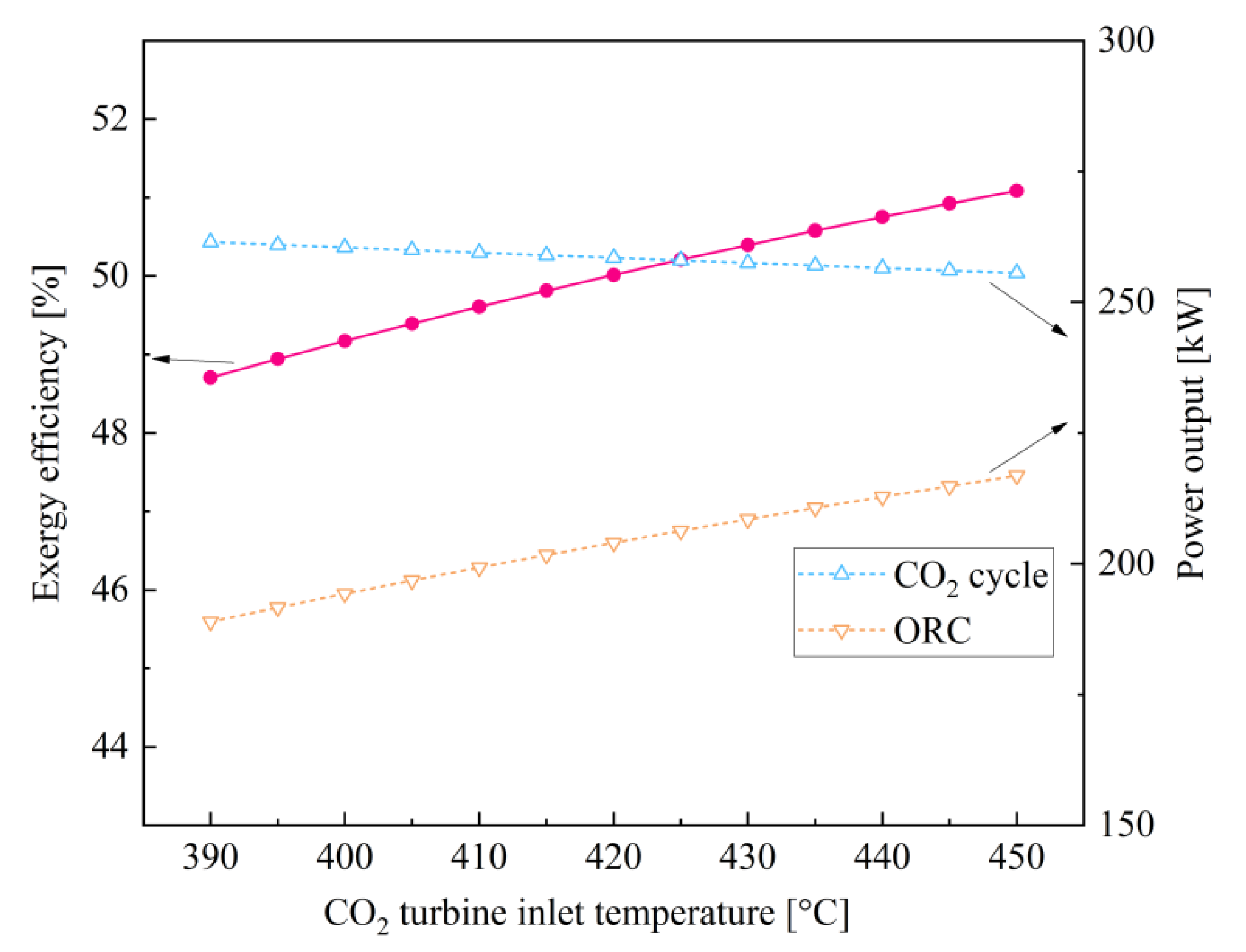
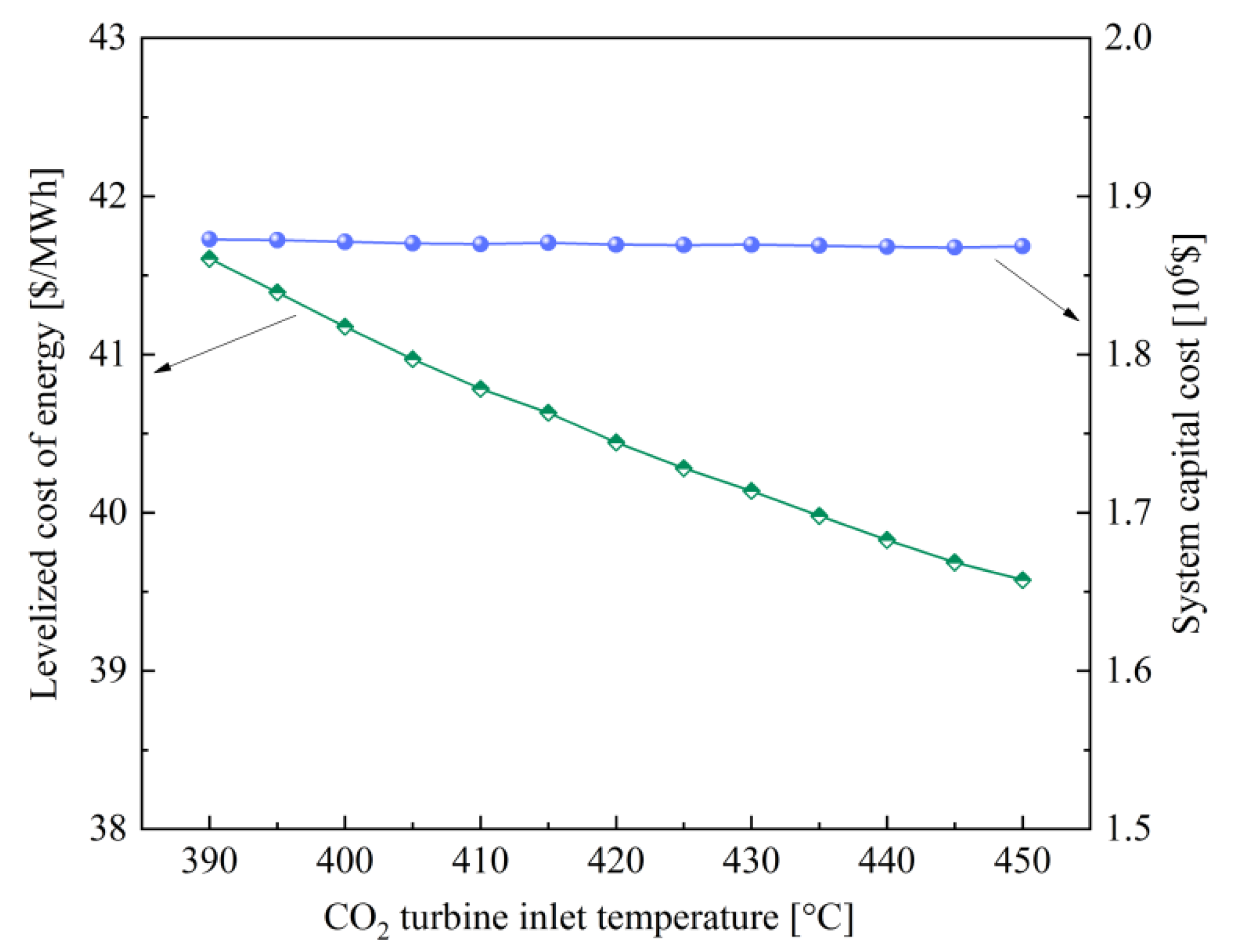

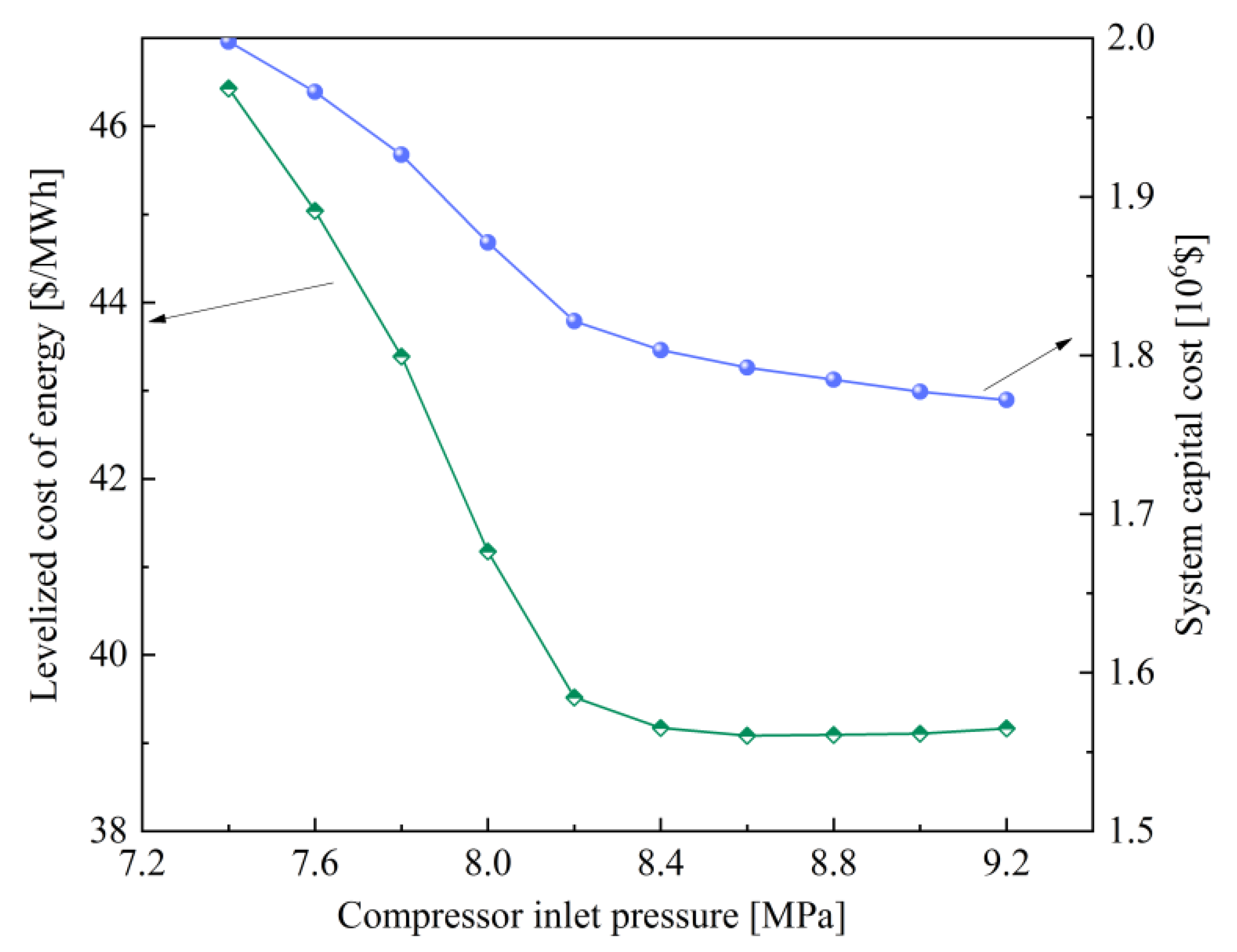
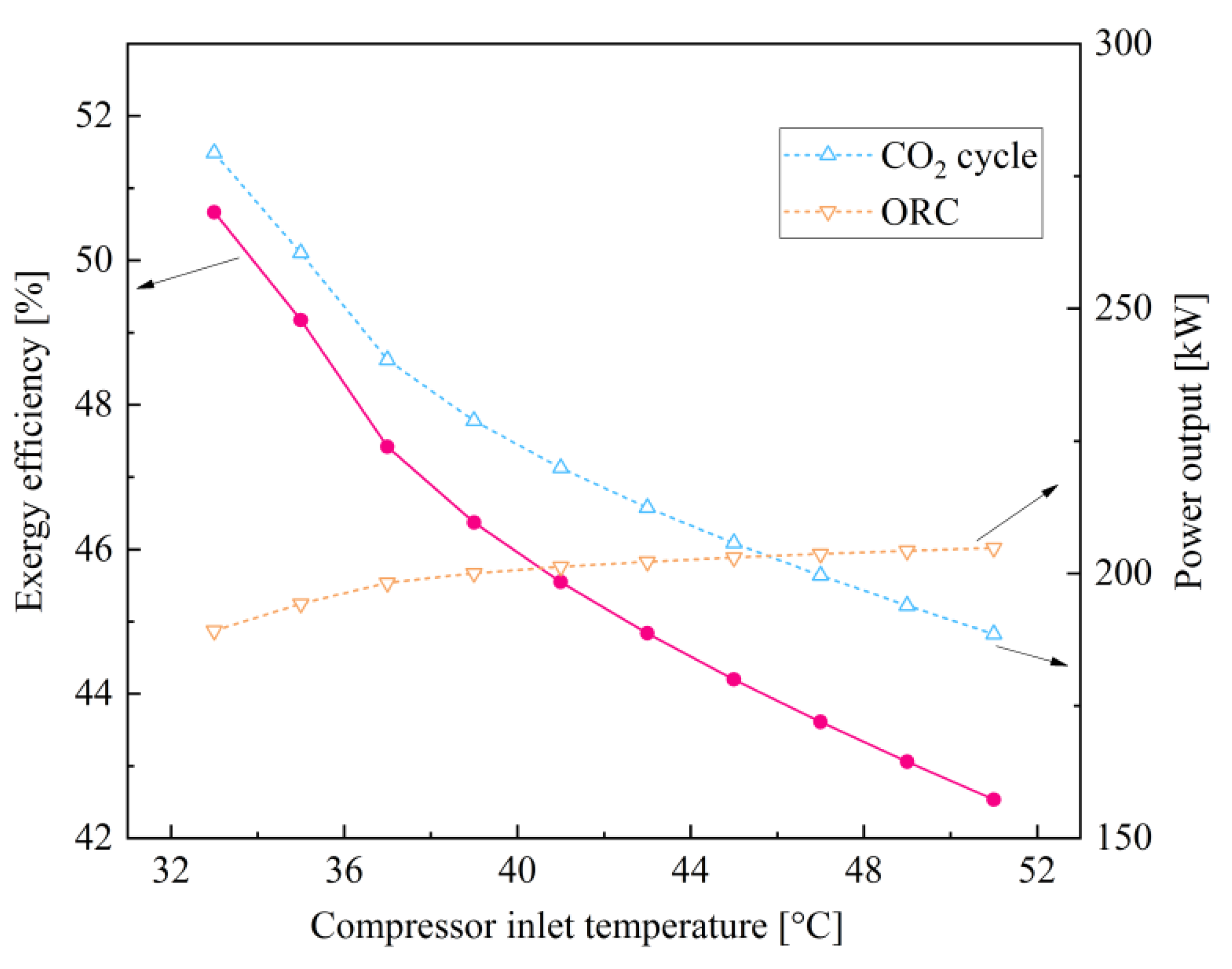
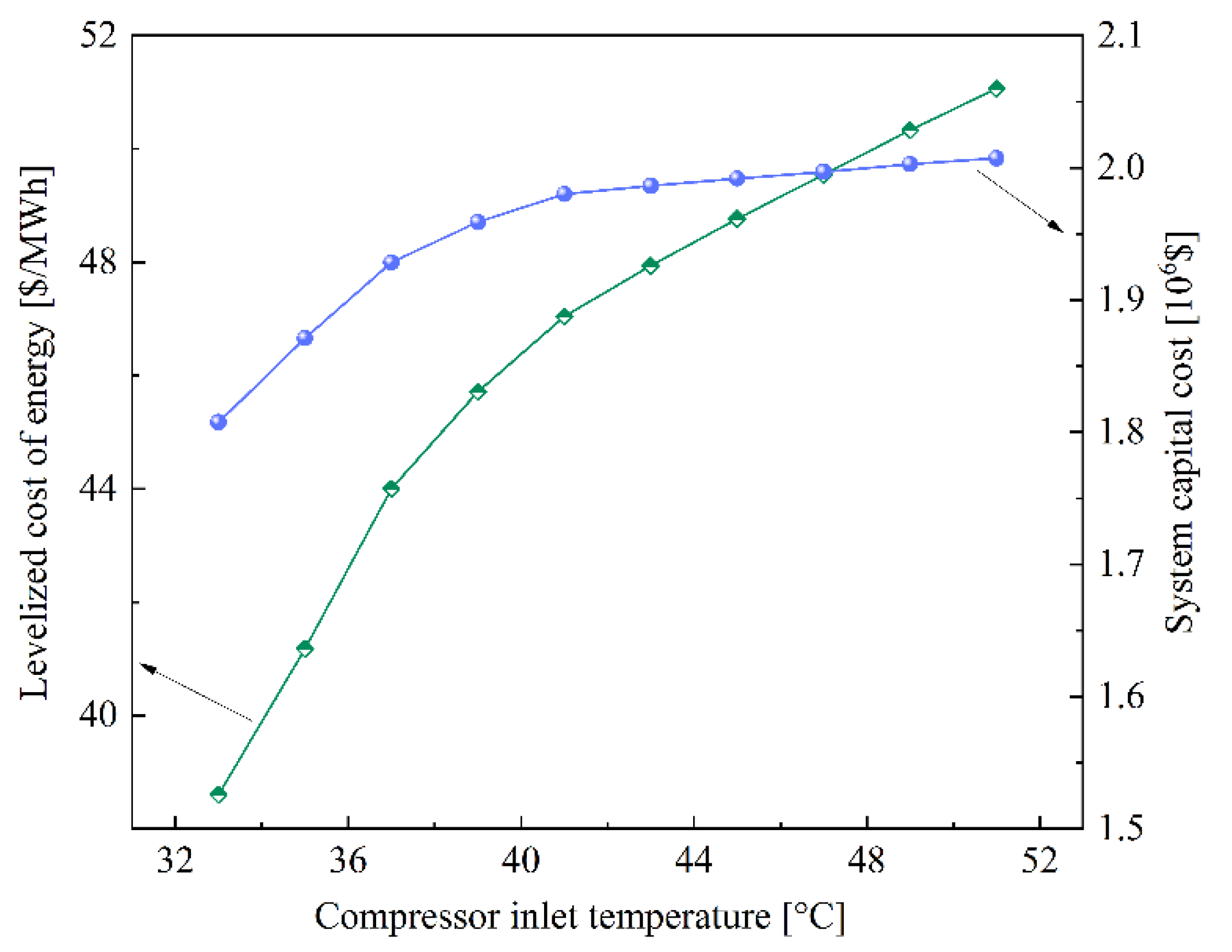
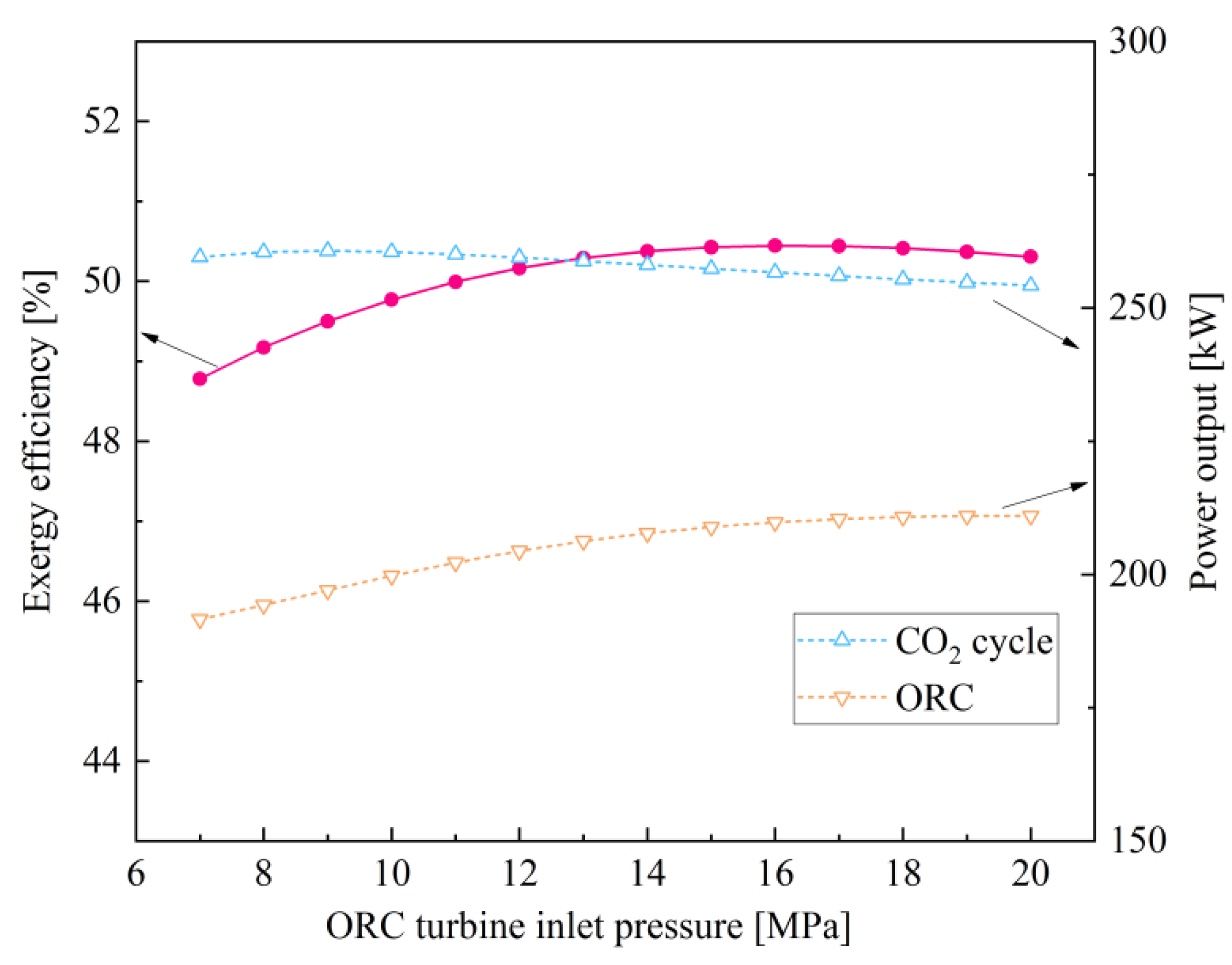
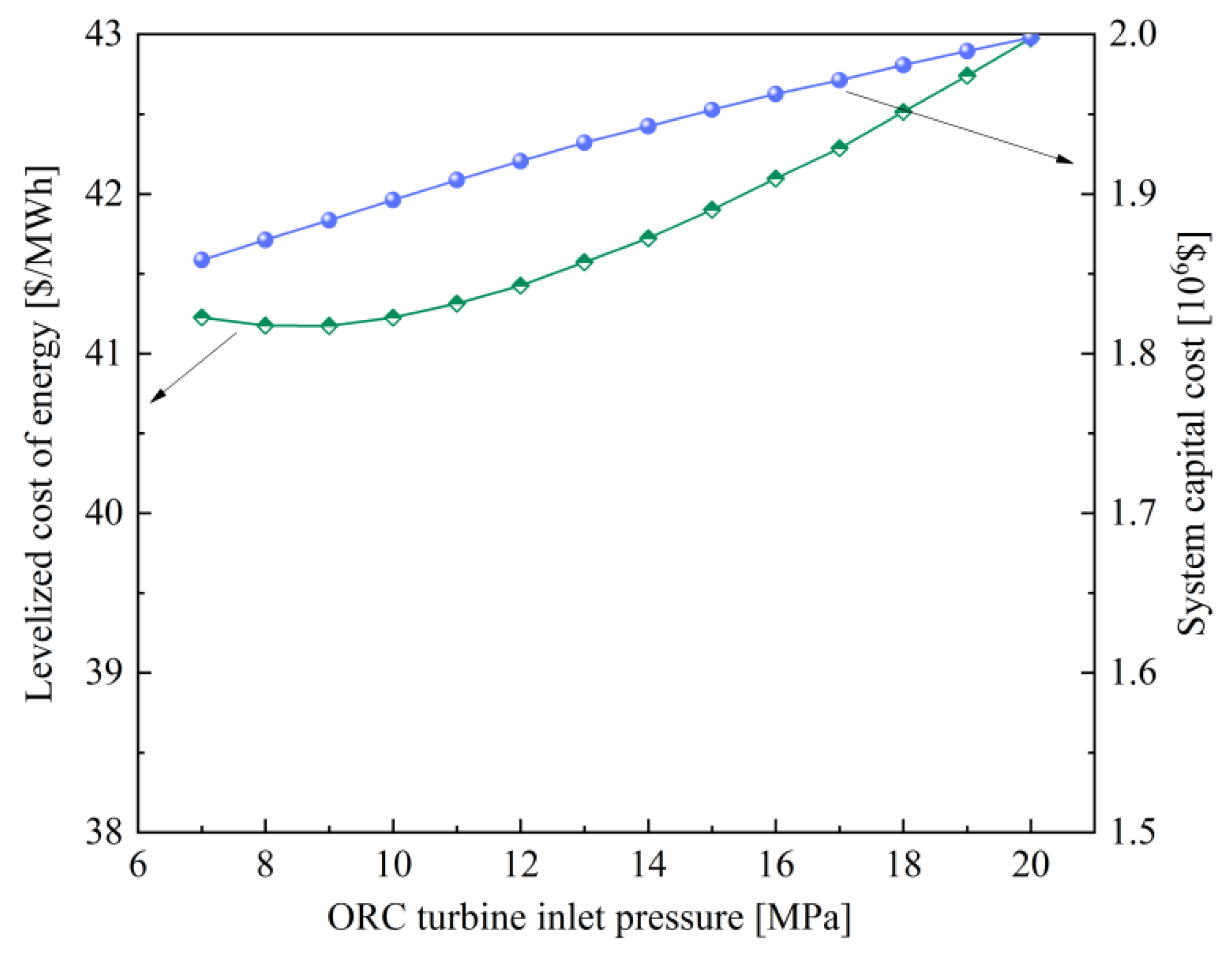
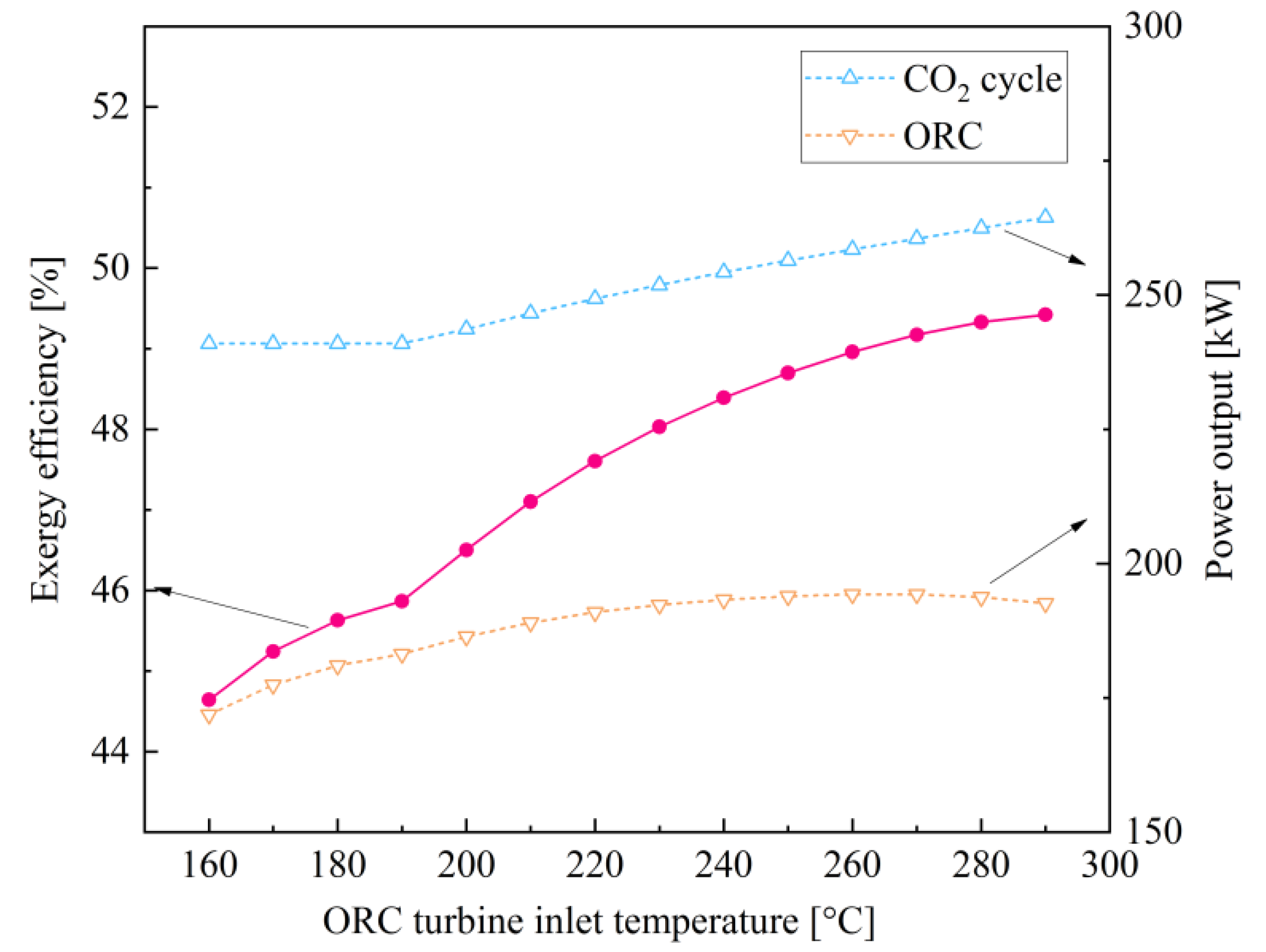
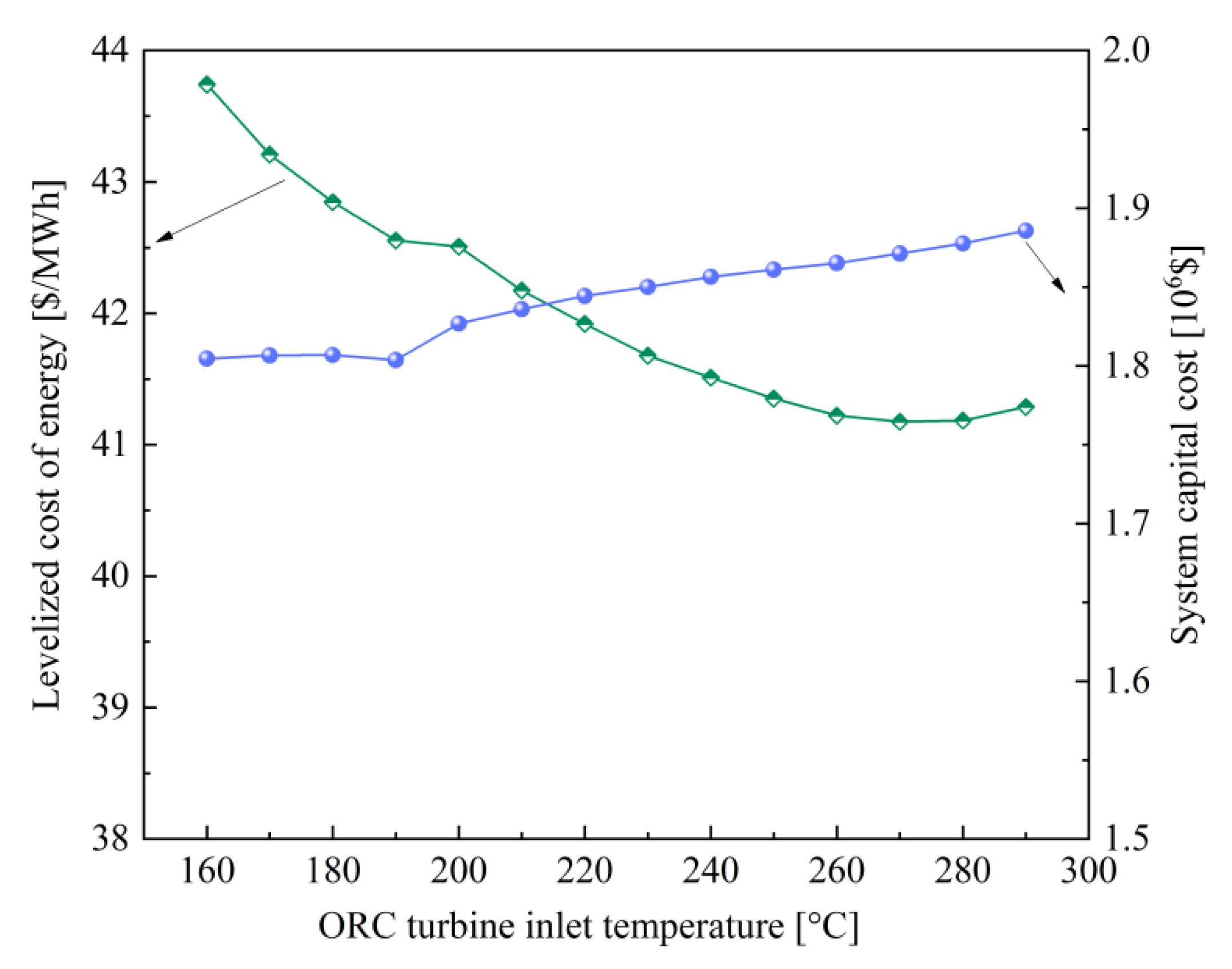

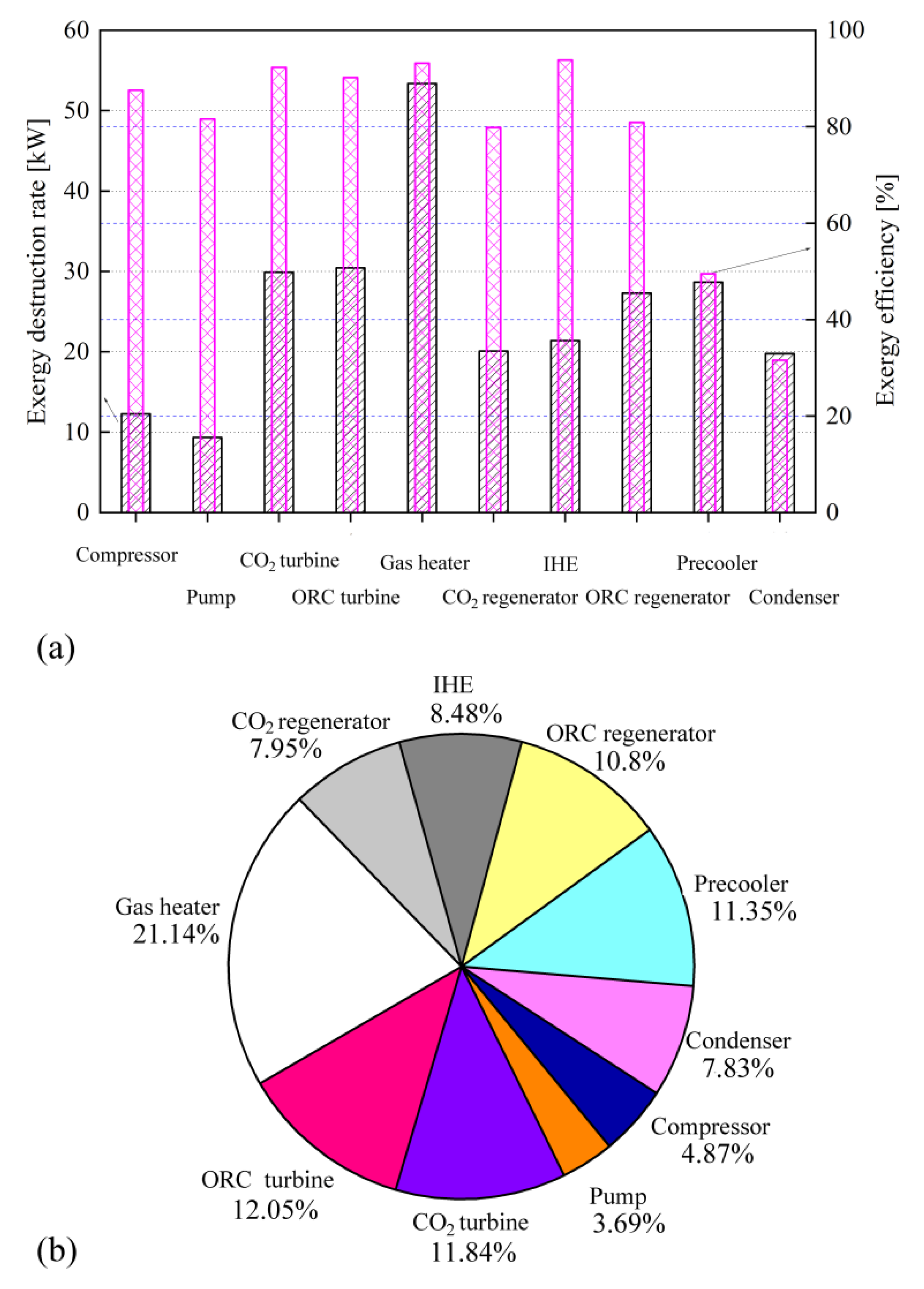
| Equipment | Fuel Exergy | Product Exergy |
|---|---|---|
| Gas heater | ||
| CO2 Turbine | ||
| CO2 regenerator | ||
| Precooler | ||
| Compressor | ||
| IHE | ||
| ORC turbine | ||
| ORC regenerator | ||
| Condenser | ||
| Pump |
| Component | y1 | y2 | z |
|---|---|---|---|
| Turbine | 9000 | 40,000 | 0.69 |
| Compressor | 9000 | 20,000 | 0.6 |
| Pump | 1500 | 50,000 | 0.8 |
| Heat exchanger | 900 | 10,000 | 0.82 |
| Parameter | Value |
|---|---|
| Ambient pressure (MPa) | 0.1013 |
| Ambient temperature (°C) | 20 |
| Mass flow of exhaust gas (kg/s) | 4.35 |
| Temperature of exhaust gas (°C) | 470 |
| Inlet pressure of CO2 turbine (MPa) | 20 |
| Compressor inlet pressure (MPa) | 8 |
| Inlet temperature of CO2 turbine (°C) | 400 |
| Compressor inlet temperature (°C) | 35 |
| Inlet pressure of ORC turbine (MPa) | 8 |
| Inlet temperature of ORC turbine (°C) | 270 |
| Condensation temperature (°C) | 35 |
| Turbine isentropic efficiency | 0.85 |
| Compressor isentropic efficiency | 0.85 |
| Pump isentropic efficiency | 0.8 |
| Temperature difference in gas heater (°C) | 20 |
| Temperature difference in precooler, | 10 |
| IHE, regenerator and condenser (°C) |
| Parameters | Value |
|---|---|
| pCO2T,in (MPa) | 20.78 |
| TCO2T,in (°C) | 431.57 |
| pORCT,in (MPa) | 17.25 |
| TORCT,in (°C) | 308.47 |
| Exergy efficiency (%) | 54.63 |
| LCOE (USD/MWh) | 36.95 |
Publisher’s Note: MDPI stays neutral with regard to jurisdictional claims in published maps and institutional affiliations. |
© 2022 by the authors. Licensee MDPI, Basel, Switzerland. This article is an open access article distributed under the terms and conditions of the Creative Commons Attribution (CC BY) license (https://creativecommons.org/licenses/by/4.0/).
Share and Cite
Ma, H.; Liu, Z. An Engine Exhaust Utilization System by Combining CO2 Brayton Cycle and Transcritical Organic Rankine Cycle. Sustainability 2022, 14, 1276. https://doi.org/10.3390/su14031276
Ma H, Liu Z. An Engine Exhaust Utilization System by Combining CO2 Brayton Cycle and Transcritical Organic Rankine Cycle. Sustainability. 2022; 14(3):1276. https://doi.org/10.3390/su14031276
Chicago/Turabian StyleMa, Haoyuan, and Zhan Liu. 2022. "An Engine Exhaust Utilization System by Combining CO2 Brayton Cycle and Transcritical Organic Rankine Cycle" Sustainability 14, no. 3: 1276. https://doi.org/10.3390/su14031276
APA StyleMa, H., & Liu, Z. (2022). An Engine Exhaust Utilization System by Combining CO2 Brayton Cycle and Transcritical Organic Rankine Cycle. Sustainability, 14(3), 1276. https://doi.org/10.3390/su14031276







